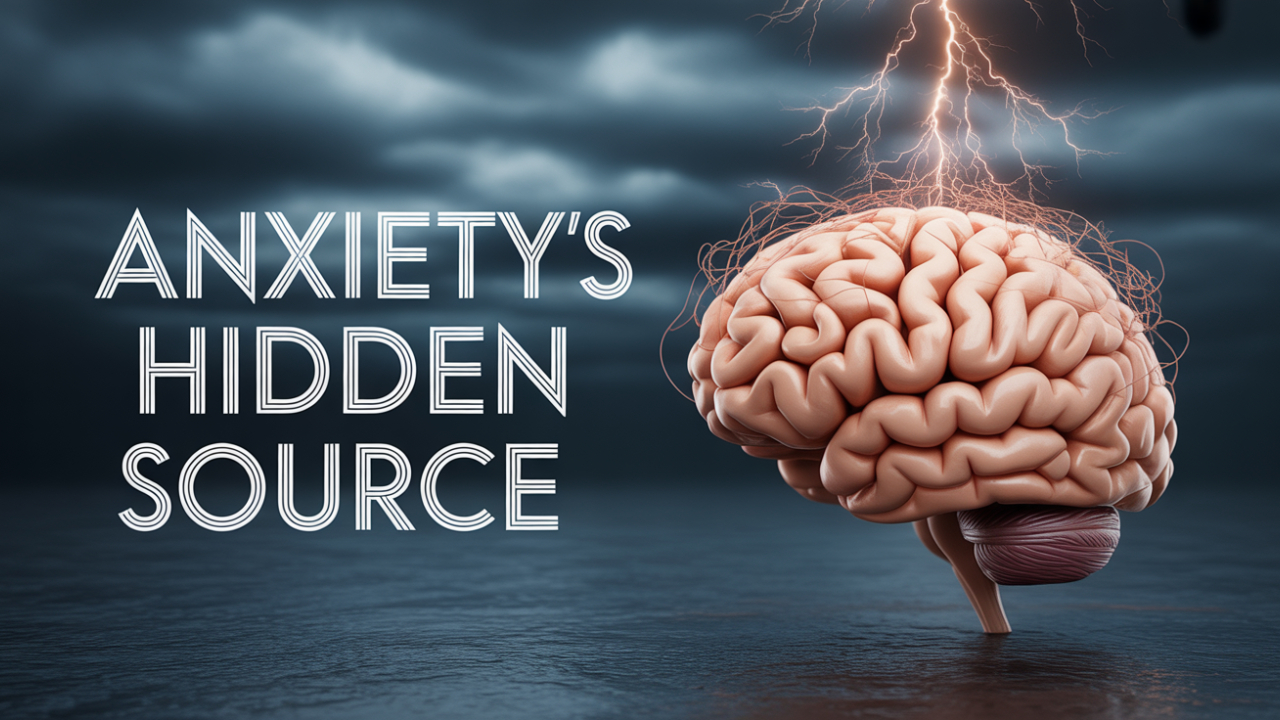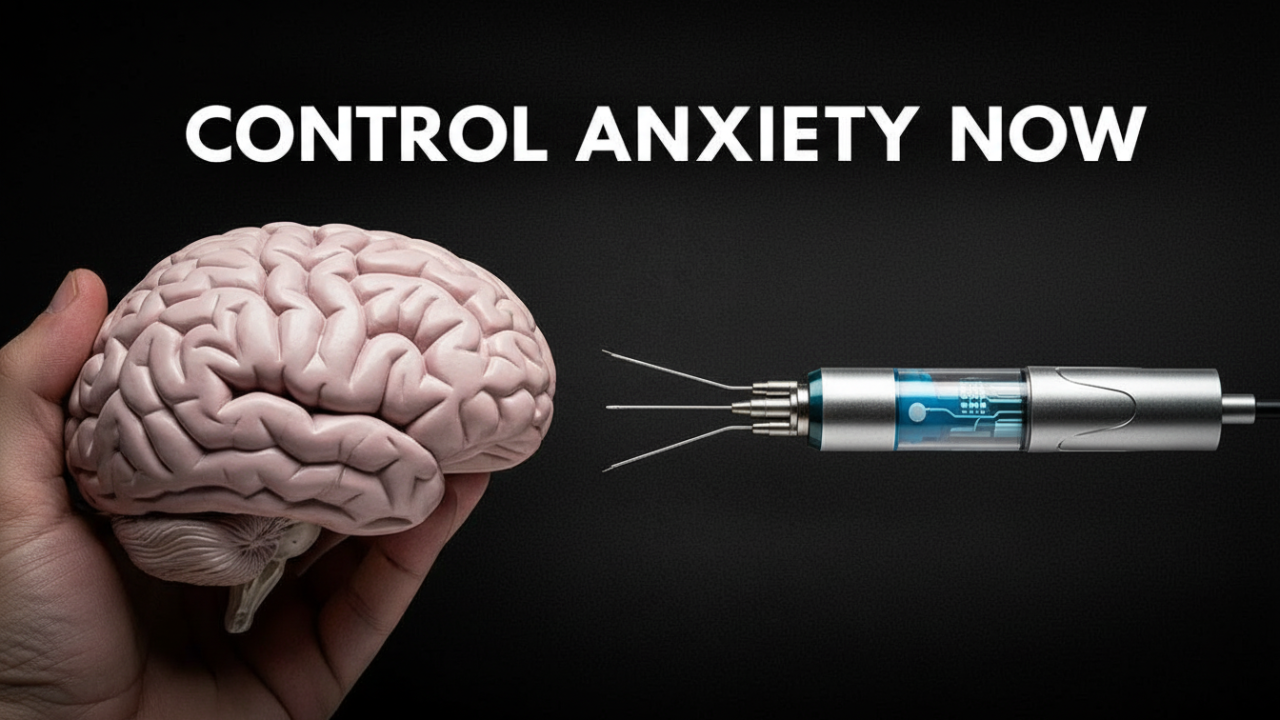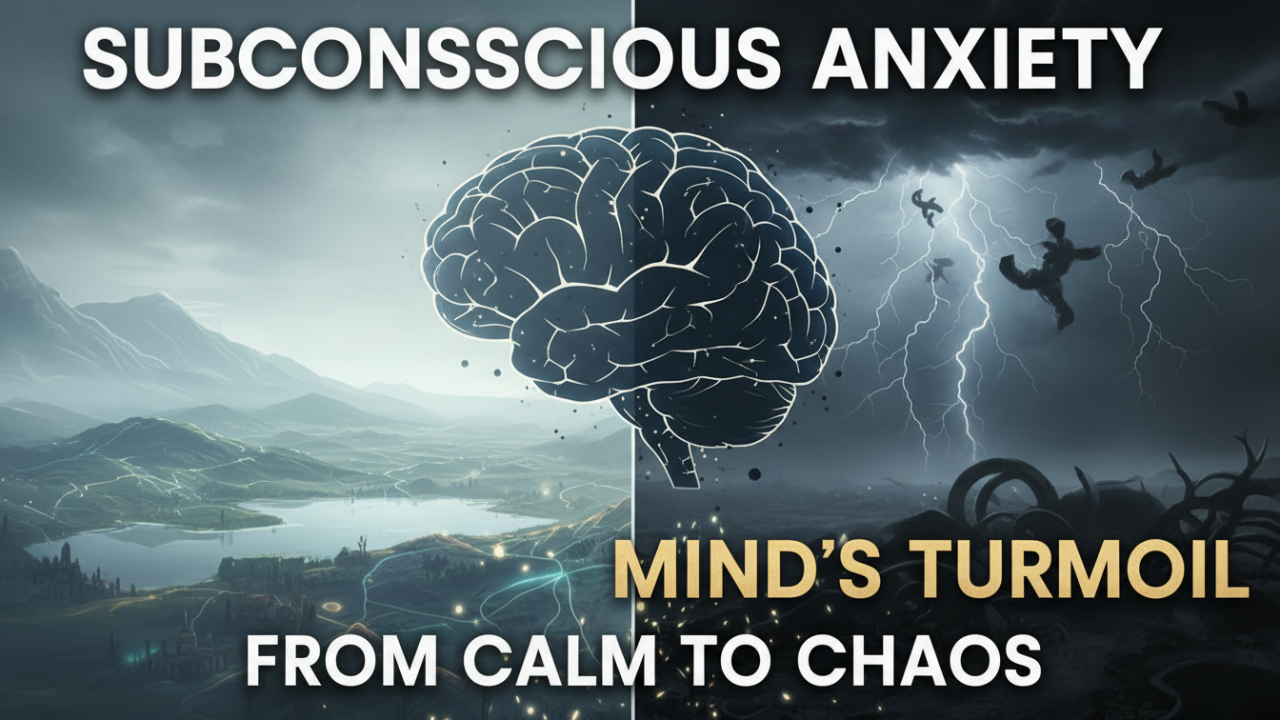What if the anxiety you feel every day isn’t really your fault? What if it’s not coming from your conscious worries about work or your future, but from a hidden part of your brain running a program it wrote years ago?
You know that feeling of panic that seems to come out of nowhere? Or that sense of dread that settles in your stomach for no reason you can pinpoint? That’s your brain’s ancient fear center, the amygdala, being triggered by a ghost. It’s a response to a danger that isn’t there anymore—a shadow from your past that your mind thinks is a monster in your present.
For years, you’ve probably tried to “think” your way out of it. You’ve told yourself to calm down, that everything’s fine, that your fears are irrational. But the feeling sticks around, doesn’t it? It can feel like you’re being betrayed by your own mind, like there’s a constant war going on inside. And that’s one of the most frustrating parts of anxiety: the logical part of you knows you’re safe, but another, more powerful part is screaming that you’re in mortal danger.
In this article , we’re going to pull back the curtain on this hidden process. We’ll explore the science of how your subconscious mind creates and holds onto anxiety, often without your permission or even your awareness. And more importantly, we’re going to talk about how to give your brain a much-needed software update. We’re not going to fight anxiety. We’re going to understand it, and then we’re going to retrain it.
This book is scientific documentary of the Kingdom of God.
**SECTION 1: THE PROBLEM DEEP DIVE – THE FEELING OF BEING BETRAYED BY YOUR OWN MIND**
Let’s be honest for a second. Does this sound familiar? You’re driving to a party, an event you actually want to go to. Everything seems fine. The sun is out, your favorite song is on, and then… a wave of dread washes over you. Your heart starts pounding. Your palms get sweaty. Your stomach twists into a knot, and you feel like you can’t breathe. Your conscious mind is scrambling for a reason. *Is it the traffic? Did I forget something? What is wrong with me?* But there’s no logical answer. The feeling is completely disconnected from what’s happening.
Or maybe for you, it’s more of a low hum. A constant, background static of unease that never really goes away. You wake up with it—a tension in your shoulders and jaw before you even get out of bed. You might be a high-achiever, a perfectionist, someone who looks like they have it all together. But on the inside, you’re running on a treadmill of hypervigilance. You find yourself over-apologizing for things that aren’t your fault. You compulsively check your emails or your work, driven by some unnamed fear of a catastrophe. These aren’t just quirks; they’re often behaviors driven by a subconscious engine of anxiety.
This is the maddening experience of subconscious anxiety. It operates just beneath the surface of your conscious thoughts. You feel the physical symptoms—the racing heart, the digestive issues, the chronic fatigue, the muscle tension—but you can’t trace them back to a specific, conscious worry. It feels like your body is stuck in a state of emergency, a perpetual fight-or-flight response, even when you’re just sitting on your couch. Your limbic system, the emotional part of your brain, is stuck in a loop, keeping you on high alert for no good reason.
For so many people, this leads to a second layer of pain: shame and confusion. You think, “Why can’t I just relax? Why am I so broken?” You feel betrayed because the very system that’s meant to keep you safe is now the source of your suffering. You might even go to doctors who run tests and tell you that, physically, you’re fine, which only deepens the mystery and the feeling that you’re losing your mind.
But here’s the most important thing you need to understand, the foundation for everything else we’ll cover: You are not broken. Your brain isn’t faulty. It’s doing exactly what it was designed to do. The problem is, it’s working from an old, outdated instruction manual. It’s running a program written a long time ago, based on experiences you might not even consciously remember. And today, we’re going to start debugging that code.
If any of this is resonating with you, and you’re tired of feeling like you’re at war with your own mind, consider liking this video and subscribing. Because we’re about to go deep into the architecture of your brain to find the source of this program and, most importantly, learn how to rewrite it.
**SECTION 2: THE EXPLANATION VIA ANALOGY – THE BODYGUARD WITH AN OUTDATED MAP**
To really get what’s happening in your mind, let’s stop thinking of anxiety as an enemy we have to defeat. Instead, I want you to imagine your subconscious mind as a deeply loyal, incredibly powerful, but sometimes misguided, personal Bodyguard.
This Bodyguard’s only job is to keep you safe. That’s its prime directive. It’s been with you your entire life, watching, learning, and taking notes. It’s fiercely protective and works 24/7, even when you’re asleep. It doesn’t operate on logic or reason like your conscious mind. It works on a much more primal level: association and emotion. And to do its job, this Bodyguard uses a few key tools.
The first and most important tool is the Panic Button. In neuroscience, this is the **amygdala**. The amygdala is an almond-shaped cluster of neurons deep in the emotional center of your brain. It’s your brain’s alarm system, designed to react to threats with lightning speed. How fast? The amygdala can receive threat information and trigger a physical response in a fraction of a second, often in less than 50 milliseconds—long before your conscious, thinking brain even knows what it has seen. This is what’s called an “amygdala hijack.” It’s the Bodyguard slamming the Panic Button before the boss—your conscious mind—has even had a chance to review the security footage. When that button gets hit, it floods your body with adrenaline and cortisol, preparing you to fight, flee, or freeze. It’s a system built for pure survival.
But how does the Bodyguard know *when* to hit the Panic Button? It decides by looking at its second tool: the Map. This Map is stored in a part of your brain called the **hippocampus** and the broader **limbic system**. The hippocampus is your brain’s memory keeper, and it’s responsible for providing context. From the moment you’re born, your Bodyguard starts creating this Map of the World. Every experience, especially those with a strong emotional kick, gets recorded. A moment of intense fear, a period of chronic stress, a painful rejection—each of these experiences creates a big, red “Danger Zone” on the Map.
Imagine a child at school. The teacher asks them to read aloud, but they stumble over the words. The other kids laugh, and the teacher makes a critical comment. In that moment, the child feels a hot surge of shame and fear. To their young brain, this feels like a major threat to their social survival. So the Bodyguard, trying to protect them, takes out a red marker and draws a huge circle on the Map around “Public Speaking,” labeling it “DANGER: AVOID AT ALL COSTS.” The smell of the classroom, the sound of the school bell, the feeling of all those eyes on them—all these details get logged as related threats. The emotional memory isn’t stored as a story, but as a powerful, non-verbal association in the amygdala.
Now, fast forward twenty years. That child is an adult, up for a promotion. Their boss asks them to give a short presentation. Consciously, the adult knows this is a great opportunity. They’re capable and prepared. But the subconscious Bodyguard isn’t looking at the present. It’s looking at that old, outdated Map. It sees that the adult is about to walk right into a “Danger Zone.”
So what does it do? It does its job. It bypasses all logic and slams the Panic Button. The amygdala fires, unleashing a full-blown threat response. The adult’s heart pounds, they feel sick, their mind goes blank. They’re feeling the same terror they felt as a child, even though the situation is completely different. The Bodyguard is reacting to a ghost. It’s trying to protect you from a lion that’s no longer there, using a map of a place you no longer live.
But it gets even more complicated. There’s another player here that explains why the anxiety doesn’t just disappear after the presentation. It’s a part of the brain called the **bed nucleus of the stria terminalis**, or **BNST**. If the amygdala is the Panic Button for immediate, in-your-face threats, the BNST is like the Sentry that’s put on patrol *after* the alarm sounds. The BNST is responsible for that sustained, long-term feeling of anxiety—the dread and worry about potential future threats.
So, after the amygdala sounds the alarm about the presentation, the BNST steps in and says, “Okay, we survived that, but what if there are more threats like it? What if the boss was unhappy? What if my colleagues are still judging me?” The BNST keeps the body in a prolonged state of alertness, a low-level anxiety that can last for hours or even days. It’s the brain structure behind that horrible feeling of “waiting for the other shoe to drop.” It takes signals from the amygdala and hippocampus and keeps your nervous system on a low simmer. This is why subconscious anxiety often feels like a constant hum of unease, not just sudden panic attacks. It’s the amygdala creating the spike of fear and the BNST creating the long, anxious plateau that follows.
And what about the boss, the conscious mind? This is your **prefrontal cortex (PFC)**, the most evolved part of your brain, right behind your forehead. The PFC handles logic, reasoning, planning, and emotional regulation. Its job is to look at the situation rationally and tell the Bodyguard, “Hey, thanks for the warning, but look closer. This isn’t a classroom of jeering kids. This is a supportive team. The map is wrong. You can stand down.”
In a well-regulated brain, there’s a strong line of communication between the PFC and the amygdala. The PFC acts as a calming brake on the amygdala’s hair-trigger alarm. But under chronic stress, or due to patterns learned in childhood, this top-down control from the PFC can get weak. It’s like the boss is out of the office, or the phone line to the Bodyguard is full of static. Stress hormones like cortisol actually weaken the PFC’s function while strengthening the amygdala’s reactivity. This creates a vicious cycle: stress makes your Bodyguard more jumpy and your rational boss less effective, which leads to more anxiety, which creates more stress.
So, when you feel that irrational wave of anxiety, it’s actually a complex, lightning-fast neural process. Your senses pick up a trigger that your subconscious Bodyguard links to a “Danger Zone” on its old Map. It hits the Panic Button (amygdala), flooding you with stress hormones. Your rational boss (PFC) is temporarily offline or ignored. And then the Sentry (BNST) comes on duty to keep you in a state of sustained watchfulness, just in case.
This isn’t your fault. You didn’t choose this. It’s a deeply ingrained survival mechanism. That feeling of being betrayed by your mind is simply the conflict between your conscious desire to feel safe and your Bodyguard’s unwavering—if misguided—commitment to protecting you based on old information. The good news? You don’t have to fire the Bodyguard. You just need to become its trusted guide. You need to teach it how to read a new, updated map.
**SECTION 3: THE SOLUTION – GIVING YOUR BODYGUARD A NEW MAP**
This is where things start to shift. Understanding the “why” is interesting, but knowing the “how” is empowering. For years, you’ve probably been trying to fight your anxiety, to argue with it. This is like shouting at your Bodyguard for doing its job. It only makes the Bodyguard more agitated and convinced there’s a real threat. The goal isn’t to get rid of your Bodyguard; its protective instinct is vital. The goal is to build a new relationship with it—one based on trust and teamwork. The goal is to gently and patiently help it draw a new map of your world, one that reflects your current reality, not your past dangers.
This is a process of retraining, based on the incredible principle of neuroplasticity—your brain’s ability to rewire itself based on new experiences. Every step we take is about creating new neural pathways that signal safety and calm.
**Step 1: Acknowledge and Reassure the Bodyguard**
The first step is the most counterintuitive, but it’s also the most powerful. When you feel that familiar surge of anxiety—the racing heart, the tight chest—your instinct is probably to push it away or hate it. Instead, I want you to do the opposite. Pause, take a breath, and mentally turn toward the feeling.
Say to yourself, silently or out loud, something like: “Ah, there’s that feeling. Hello, anxiety.” Then, and this is the key part, acknowledge the protector behind it. “Thank you, subconscious mind, for trying to protect me. I know you’ve just hit the alarm because you think I’m in danger. I appreciate you looking out for me, but right now, in this moment, I am safe.”
What does this simple act do on a brain level? It’s profound.
First, by labeling the feeling—”This is anxiety”—you’re activating your prefrontal cortex, the rational boss. You’re shifting out of the purely emotional, reactive brain and into your observing, thinking brain. The simple act of naming it creates a bit of space between “you” and the feeling. You aren’t the anxiety; you’re the one *observing* it. This helps the PFC start to regain control over the hyperactive amygdala.
Second, by saying “Thank you,” you’re changing your relationship with the experience from one of conflict to one of compassion. You’re signaling to your nervous system that the feeling itself is not a threat. So much of the suffering in a panic attack comes from the “second fear”—the fear of the fear itself. By thanking the Bodyguard, you short-circuit that feedback loop.
Third, by gently reassuring it—”I am safe right now”—you begin updating the map. You are providing new, real-time data that contradicts the old, stored data. You’re holding up the new map and saying, “See? This spot isn’t red anymore. It’s green. We’re okay here.”
This isn’t about pretending the feeling isn’t there. It’s about welcoming it as a misguided message and calmly correcting the information. Doing this consistently starts to lower your baseline level of hypervigilance. The Bodyguard begins to learn that not every alarm requires a full-scale evacuation.
**Step 2: Draw the New Map**
Acknowledging the Bodyguard helps calm the system. Now, we need to actively give it new experiences to prove the old map is wrong. This is where we use conscious techniques to create new, safe associations.
* **Micro-Exposures:** To convince the Bodyguard that public speaking isn’t a mortal threat, you have to *show* it. This doesn’t mean booking a TED talk tomorrow. It means starting small, with “micro-exposures.” You intentionally and gradually step into the “Danger Zones” on your old map and let your nervous system have a neutral or even positive experience. If you have social anxiety, a micro-exposure might just be making eye contact with a cashier and saying “have a nice day.” That’s it. The goal is to do it and let your Bodyguard see that the world didn’t end. Each time you do this, you’re drawing a tiny new data point on the map, showing the Bodyguard, “See? This little part of the territory is safe.” Over time, these small safe zones connect and start to overwrite the old red ones.
* **Guided Visualization:** Sometimes, a real-world exposure feels like too much. That’s fine. You can use your imagination to practice in a safe, controlled way. Your brain often has a hard time telling the difference between a vividly imagined experience and a real one. Find a quiet place and close your eyes. First, imagine a place where you feel completely safe and calm. Feel that safety in your body. Now, from this safe place, imagine watching yourself approach the feared situation on a movie screen. See yourself walking to the podium, delivering the first line calmly. Imagine the audience nodding. Feel a sense of accomplishment. If you start to feel anxious, just “zoom out” and bring your awareness back to your safe place. This is like a flight simulator for your nervous system, allowing your Bodyguard to get used to the “dangerous” territory without actually being thrown into it.
* **Interrupt and Reframe the Story:** Your Bodyguard doesn’t just react to situations; it reacts to the stories you tell yourself. Anxious thoughts are often catastrophic predictions: “I’m going to fail,” or “Everyone will think I’m an idiot.” These thoughts are like gasoline on the amygdala’s fire. The technique here is not to suppress the thought, but to catch it, label it, and gently reframe it. When the thought “I’m going to mess this up” appears, first, catch it. “Ah, I notice I’m having the thought that I’m going to mess up.” Then, ask yourself a simple question: “What else could be true?” A more balanced thought might be, “I’m nervous about this, which is normal. I’ve prepared for it, and I can handle it.” Or, “I might make a small mistake, and that’s okay. It’s not a catastrophe.” You’re actively replacing the black-and-white thinking of the amygdala with the more nuanced thinking of the prefrontal cortex. You’re changing the script.
**Step 3: Long-Term Maintenance – Keeping the Map Updated**
Rewiring your brain isn’t a one-time thing; it’s an ongoing practice of taking care of your nervous system. Think of it as giving your Bodyguard the resources it needs to stay calm, focused, and trusting of your leadership.
* **Prioritize Deep Rest and Sleep:** Sleep is when your brain cleans house. It processes emotional experiences and regulates the hormones that control stress. When you’re sleep-deprived, your amygdala becomes far more reactive, and its connection to your rational prefrontal cortex weakens. Prioritizing 7-9 hours of quality sleep is one of the most powerful anti-anxiety strategies there is.
* **Move Your Body:** When the Panic Button gets pushed, your body is flooded with energy meant for fighting or fleeing. If you just sit with that energy, it can create tension and restlessness. Physical exercise—a brisk walk, a run, dancing—helps you complete the stress cycle. It burns off excess adrenaline and cortisol and releases endorphins, which have a naturally calming effect. You are physically showing your Bodyguard that you’ve successfully “escaped” the danger, helping the nervous system return to a state of rest.
* **Regulate Your Nervous System with Your Breath:** Your breath is like a remote control for your nervous system. When you’re anxious, your breathing gets shallow and rapid, signaling danger. By consciously slowing down your breath, you can manually switch your body from the fight-or-flight system to the rest-and-digest system. A simple technique is the physiological sigh: a double inhale through the nose, followed by a long, slow exhale through the mouth. Doing this just two or three times can send a powerful signal of safety straight to your brainstem, telling the Bodyguard that the threat has passed.
This journey is about becoming an active participant in your own mental wellbeing. It’s about moving from being a passenger on a runaway train to becoming the calm, compassionate conductor. It requires patience and self-compassion. There will be days when the old programming runs strong. On those days, your job isn’t to get discouraged. It’s to simply return to Step 1: Acknowledge, thank, and reassure. Every single time you do, you strengthen that new neural pathway.
**CONCLUSION **
We’ve explored the hidden architecture of your mind today. We’ve seen that the anxiety you feel—that visceral, often illogical sense of dread—is not a personal failing or a sign of weakness. It’s the echo of an ancient survival mechanism, a loyal Bodyguard working to protect you with an old map.
We’ve met the key players: the lightning-fast **amygdala**, our Panic Button; the **hippocampus**, the memory’s Map Room; the **BNST**, the vigilant Sentry that keeps us on edge; and the **prefrontal cortex**, the rational Boss who can get sidelined. Understanding this system is the key to freeing yourself. When you know *why* it’s happening, the feeling loses some of its terrifying power. It shifts from being a monster into a misguided friend.
So, here’s the main takeaway: your power lies not in fighting your anxiety, but in befriending and retraining it. By acknowledging your inner protector, by gently showing it the world has changed, and by reframing the stories you tell yourself, you can literally redraw your brain’s map. You can teach your Bodyguard that what was once a threat is now safe.
This is the path to real freedom from anxiety. It’s not a quick fix, but a practice of becoming your own guide and working *with* your brain instead of against it. Your job is no longer to fight the Bodyguard; it is to become its trusted leader.
Thank you for spending this time with me. Be patient with yourself, and be kind to your Bodyguard







